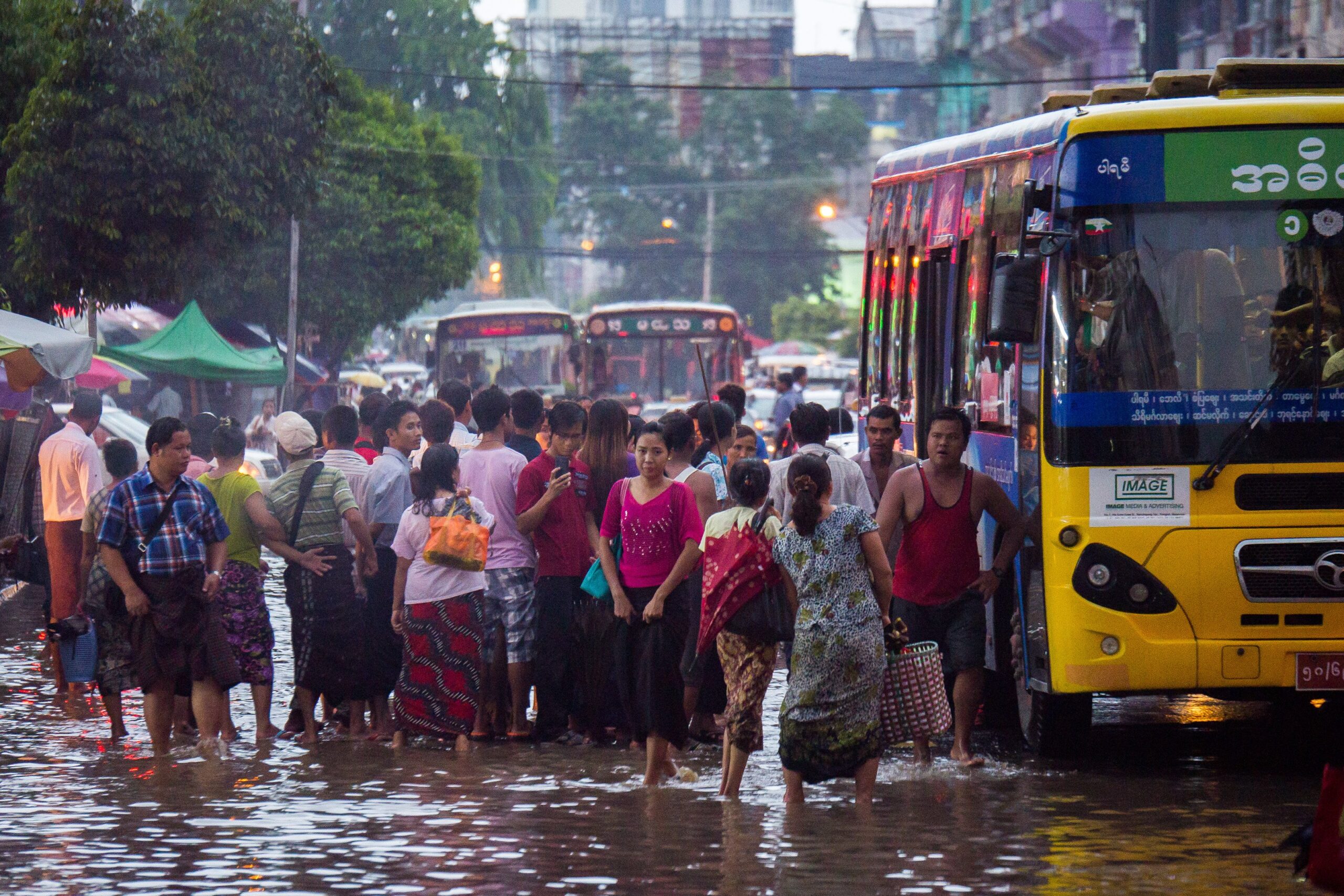
State of Indo-Pacific Nations Ahead of Climate Summit

Officials from more than 190 nations will meet in Dubai for two weeks beginning November 30 for the Conference of the Parties, known as COP28, to discuss plans and ideas to step up the world’s shift away from burning fossil fuels that are rapidly heating our planet. The conference takes place at the end of a year that has experienced catastrophic forest fires, storms, flooding, heat waves and crop failures.
One of the goals of the meeting is to assess whether countries are on track to meet the goals they set in Paris in 2015 to keep average global temperatures from rising higher than 1.5 degrees Celsius (2.8 degrees Fahrenheit) above temperatures prior to industrialization.
A second objective is to jump-start a fund agreed to at last year’s summit to help poorer and most vulnerable nations address the worst impacts of climate change. The expectation is that industrialized nations that contributed most to greenhouse gas emissions will provide funds, but little progress has been made over the past year.
A third goal will be to elicit commitments from countries to reduce carbon dioxide emissions from coal-fired power plants, factories and gas-powered vehicles to ensure the earth does not warm beyond 2 degrees Celsius by 2100.
Although most countries are taking more concrete measures to confront climate change, they are not doing enough to maintain temperatures low enough to prevent serious devastation, a recent United Nations synthesis report warned. The report delivered disappointing news on this front in advance of the conference, noting the current goals of countries put the planet on a trajectory to heat up around 2.5-2.9 degrees Celsius above the levels before industrialization by 2100. If the Group of 20’s inability to secure a commitment for the phaseout of unabated fossil fuels serves as a harbinger of COP negotiations, the report’s troubling findings may not catalyze such a global moratorium.
The recent summit between U.S. President Joe Biden and Chinese President Xi Jinping produced notable climate outcomes that inject some optimism for meaningful COP28 outcomes, similar to the momentum building in advance of the Paris Agreement. Notably, COP28 may ultimately be remembered as the COP that secured the necessary pledges and industry commitments to address methane emissions, which was a central focus of the meetings of the U.S. and climate envoys just before the Xi-Biden summit. Their agreements are known as the Sunnylands statement. Considering China thwarted U.S.-led efforts at the Asia-Pacific Economic Cooperation summit to secure a multilateral methane emission reduction target earlier this year, the Sunnylands outcome is an important shift in China’s willingness to tackle super pollutants in its 2035 nationally determined contribution, opening the door to a broader methane agreement at COP28. An agreement on methane would be an encouraging advancement, but it would not be the same scale of breakthrough that yielded Paris. Discord over climate finance and unfulfilled COP27 commitments on losses and damage funding will neuter hopes for a more comprehensive agreement.
In advance of COP28, BGA below provides a snapshot about the impact of climate change on major economies in the Indo-Pacific along with steps they are taking to rein in greenhouse gas emissions and, for less developed nations, their hopes for the so-called “loss and damage” fund.
BGA’s Energy, Climate and Resources (ECR) team, led by Senior Director Bradford Simmons, will continue to monitor COP28 and apprise clients of updates as they occur. If you have any questions about the environmental challenges or energy developments in any of the countries listed below, please feel free to direct your queries to the relevant country lead.

Best Regards,
BGA Indo-Pacific Team and ECR Team
Southeast Asia | Indonesia | Malaysia | Myanmar | Philippines | Singapore | Thailand | Vietnam
Northeast Asia | China | Japan | Korea | Taiwan
South Asia | Bangladesh | India | Pakistan
The Pacific | Australia | New Zealand
BGA Indo-Pacific Team | BGA ECR Team
SOUTHEAST ASIA
- Southeast Asia saw record-breaking high temperatures throughout the spring and summer. The outsize impact of El Nino in the region has led to reduced rainfall and an increased risk of wildfires across Southeast Asia.
- The Asian Development Bank estimated in 2015 that Southeast Asia could lose 11 percent of its GDP by 2100 due to climate change. (Asian Development Bank)
- Agriculture and fisheries are most vulnerable to climate change, undermining production in key commodities such as palm oil, rice and coffee.
![]() Indonesia
Indonesia
- Indonesia, the world’s largest archipelagic state with diverse geography, faces significant vulnerability to climate change impacts, including floods, droughts, rising sea levels, shifts in rainfall patterns and rising temperatures. This is worsened by the country’s high population density in hazard-prone areas and its heavy reliance on natural resources. Experts predict the disappearance of thousands of islands and millions of coastal houses by 2050, with climate change costs ranging from 2.5-7 percent of the GDP, disproportionately affecting the poorest.
- Jakarta, the world’s fastest-sinking city, could see one-third of its area submerged by 2050 due to unrestricted groundwater extraction exacerbated by climate change. The city consistently ranks among the world’s most polluted, primarily due to nearby coal power plants, which has led to a public health crisis.
- This year saw the return of vast peat fires across Sumatra, which spread toxic smog throughout Indonesia, Singapore and Malaysia. This year’s fire was less widespread than in 2019, but the frequency of major fires in Indonesia is increasing.
- Climate change poses a threat to rice production in Indonesia, with El Nino patterns and higher temperatures impacting the wet season and reducing crop yields. These challenges, coupled with other agricultural threats, threaten the country’s food security.
- Indonesia has pledged to cut its emissions by 31.9 percent on its own and 43.2 percent with international support by 2030. It has committed to achieve net-zero emissions by 2060. Although Indonesia offers some incentives for electric vehicles and a voluntary carbon credit trading scheme, it has not developed clear policies to achieve its emissions goals. Indonesia is not on track to meet its Paris climate pledge. (Reuters, CAT)
- Indonesia relies heavily on coal for energy consumption and is one of its largest global producers and exporters. The country is backtracking on coal-centered retirement projects and is now focused on emission-reduction initiatives like carbon capture and storage.
- The government has placed a strong emphasis on investing in Indonesia’s green energy sector. Indonesia has entered into a $20 billion agreement with Group of Seven countries to incentivize renewable energy development through the Just Energy Transition Partnership, launched last year. The country is also party to the Indonesia-China Energy Transition Cooperation dialogue.
- President Joko “Jokowi” Widodo has taken steps to foster the development of downstream industries related to minerals crucial to the green economy — primarily nickel, bauxite and copper — by implementing export bans. However, these efforts prioritize immediate economic growth over addressing climate change.
![]() Malaysia
Malaysia
- Due to El Nino conditions, Malaysia may see a 20-40 percent reduction in rainfall in 2023 and a rise in average temperatures between 0.5 to 1.0 degrees Celsius (0.9-1.8 degrees Fahrenheit). Malaysia has sought to seed clouds to increase the water supply in Penang, which is home to the country’s semiconductor manufacturing facilities that are powered by hydropower dams. (South China Morning Post)
- El Nino may lead to a reduction in palm oil output by 3 million tons in 2024. Malaysia produced 18.5 million tons of palm oil last year. (Nikkei Asia)
- Rain-triggered flooding rocked Malaysia’s southern Johor state in March, displacing more than 50,000 people and killing at least four. (Al Jazeera)
- Malaysia pledged to reduce carbon emissions by 45 percent by 2030 and become carbon neutral by 2050. As of 2019, the country has reduced its carbon emissions by 33 percent. Malaysia has introduced electric vehicle incentives and a voluntary carbon credit scheme and recently passed the Energy Efficiency and Conservation Act, which mandates that the largest energy consumers implement power-saving measures. (Net Readiness Index, Reuters)
- In line with its pledge to reduce carbon emissions, Malaysia in August launched the National Energy Transition Roadmap (NETR), a comprehensive strategy to develop a sustainable energy system. The plan comprises 10 pivotal projects and six transition levers, emphasizing the shift from fossil fuels to a green economy. Recognizing the energy sector as a major contributor to Malaysia’s carbon footprint, the NETR sets a target of 70 percent renewable energy capacity by 2050. (Ministry of Economy)
![]() Myanmar
Myanmar
- Between July and August, flooding from heavy monsoon rains has killed five people, displaced 60,000 and destroyed key transportation infrastructure. Affected regions include the southern states of Kayin and Mon and the western state of Rakhine. A landslide caused by heavy rain recently swept away a 200-foot-long section of a major mountain highway linking Kawkareik and Maywaddy in eastern Kayin state, cutting off a busy trade route. (ABC)
- Heavy rainfall in early October caused floods in southern Myanmar. Bago region experienced the most severe damage, with the Yangon region and Mon state partly affected. According to the Myanmar Department of Meteorology and Hydrology, rainfall in Bago township measured almost 8 inches, the most in 59 years. Flooding has resulted in five causalities, 35 injuries and the displacements of nearly 30,000 people. State-owned media reported that the flood damaged around 100,000 acres of paddy fields — 4 percent of the total — in Bago region alone.
- Cyclone Mocha hit the northwest coast of Myanmar in May, killing more than 400 people and affecting 150,000. Flooding in Rakhine state was particularly devastating, impacting people displaced from years of war and genocide. (CNN)
- The deposed Myanmar government’s 2019 Myanmar Climate Change Policy outlines a goal to become climate resilient by 2030, but plans were stalled following the 2021 coup. The escalation of armed conflict is fueling the war economy. The military-led State Administration Council, challenged economically and militarily, has turned to natural resource extraction for revenue. Other armed groups are increasingly partaking in unregulated mining activity. In parallel, the military crackdown on civil society organizations and environmental activists has severely undermined disaster risk-reduction efforts. Together, these factors have exposed Myanmar to more severe climate change impacts.
![]() Philippines
Philippines
- The Philippines ranks fourth globally among the countries most affected by climate change from 1999 to 2019. This includes impacts of weather-related loss events such as storms, floods and heat waves. (Germanwatch)
- Natural disasters and extreme weather events will pose the most severe threat to the Philippine economy in the next two years, according to the country’s business leaders. (World Economic Forum)
- El Nino conditions led to predictions that the Philippines would face a drop in rice production by 1.8 percent and corn production by 1.0 percent in 2023. This caused the price of grains to spike in September, leading the government to implement a price cap on rice until early October. (Radio Free Asia)
- Between 2016 and 2021, 40 percent of all children displaced globally due to extreme weather were Filipino, with 17.2 million children uprooted from their homes. (ABC)
- Metro Manila’s sea level continues to rise. From 1901 to 2022, it rose a third of an inch per year, nearly three times higher than the global average. This increased sea level rise is attributed to human activities, such as groundwater and oil and gas mining, vegetation clearing, deforestation, population growth, urbanization and land reclamation. (CNN)
- The Philippines has not set a net-zero emissions target. It has committed to a 2.7 percent unconditional emissions reduction with a 75 percent emission reduction conditional on international support in the sectors of agriculture, waste, industry, transport and energy. The forestry sector has not been included as an emitting sector because the Philippines has claimed it to be a “net sink.” The Philippines is not on track to meet its Paris climate pledge. (United Nations Development Program, Climate Action Tracker)
![]() Singapore
Singapore
- Singapore recorded its highest temperature in 40 years at 37 Celsius (98.6 Fahrenheit) in May. (Bloomberg)
- With current forecasts indicating a potential 3-foot rise in the sea level by 2100, Singapore recently established the Coastal Protection and Flood Resilience Institute in September to build capabilities in coastal protection and flood management. (The Straits Times)
- Singapore has pledged to achieve net-zero emissions by 2050. As part of its revised 2030 nationally determined contribution, the country also committed to reducing emissions to 60 million tons of carbon dioxide equivalent by 2030 after peaking emissions earlier. This came after strong public criticism of Singapore’s initial goals, including peaking in 2030. Some citizens claimed Singapore was not doing enough, particularly in international transport, to reduce its carbon emissions. (National Climate Change Secretariat)
- The government has accelerated various sustainability initiatives. For example, the Monetary Authority of Singapore launched the Finance for Net Zero Action Plan in April, with the aim of mobilizing financing for the net-zero transition and decarbonization activities in Singapore and the region. As an extension of this, it has also allocated SGD 15 million ($11.2 million) to extend its sustainable bond and loan grant schemes for five more years until the end of 2028. The government has expanded the schemes to include transition bonds and loans. (The Straits Times, The Business Times)
- To streamline Singapore’s sustainability reporting and data requirements, a new platform, Gprnt.ai, is scheduled to launch in the first quarter of 2024. Its initial focus will be on small and medium enterprises as the primary beneficiaries. (The Straits Times)
- The government has committed to publishing an annual report tracking the public sector’s sustainability efforts, progress and plans under GreenGov.SG starting from fiscal year 2023. All statutory boards, which report directly to ministries, are required to begin annual sustainability disclosures in fiscal year 2024. (Channel NewsAsia)
- Singapore, through the Sustainability Reporting Advisory Committee established by the Accounting and Corporate Regulatory Authority and the Singapore Exchange Regulation supported by the Ministry of Finance, is evaluating the feasibility of compulsory climate-related disclosures in accordance with the standards introduced by the International Sustainability Standards Board. The proposed requirements would apply to listed companies on the Singapore Exchange from fiscal year 2025 and to non-listed companies with revenues of SGD 1 billion ($747 million) from fiscal year 2027. The government called for industry input in August, and the final recommendations are expected to be published next year. (The Business Times)
- Singapore, alongside Norway, will co-facilitate negotiations on mitigation, including the reduction of global greenhouse gas emissions, at COP28. The government will also send 20 youth leaders to the COP28 climate talks for the first time as part of its efforts to groom sustainability leaders. (The Straits Times, The Straits Times)
![]() Thailand
Thailand
- Thailand is the world’s second-largest exporter of rice and sugar. Due to El Nino, rice production is predicted to drop 6 percent to 25 million tons from 2023-2024. Sugar cane production is expected to drop from 94 million tons in 2022 to 70-80 million tons. (Nikkei Asia)
- In spring, controlled crop burning and out-of-control forest fires in northern Thailand led to air pollution covering much of Chiang Mai in the north and spreading into Myanmar and Laos. Air quality levels were 16 times worse than healthy levels in some areas, with thousands of people checking into Thai hospitals with breathing problems. (Radio Free Asia)
- Over 20 days in April and at least 10 days in May, the heat reached feels-like temperatures above 46 degrees Celsius (115 degrees Fahrenheit). At this level, thermal heat stress becomes “extreme” and is considered life threatening, including for healthy people used to extreme humid heat. (CNN)
- Thailand has pledged to be carbon neutral by 2050, with 30 percent unconditional business-as-usual reduction by 2030 and 40 percent conditional on international support. Bangkok has pledged to achieve net-zero emissions by 2060. It has stated its intention to have 68 percent of total energy generation from renewables by 2040 and 74 percent by 2050. Thailand has ambitious electric subsidies and goals, but it is not on track to meet its Paris climate pledge. (United Nations Development Program, Climate Action Tracker)
![]() Vietnam
Vietnam
- Much of northern Vietnam and Hanoi flooded in September, due to increased rainfall and the failure of drainage systems to accommodate a rising population. Flooding has increased the risk of landslides, and in 2022, 175 people died due to natural disasters in the country. (Reuters, Voice of Vietnam)
- Vietnam’s portion of the Mekong Delta is sinking, and large parts of it are expected to be fully submerged by 2080. The delta helps feed nearly 200 million people and is home to 19 million. Ground water extraction and rising sea levels will lead to more land loss. (Voice of America)
- The Mekong Delta’s increased salinity has led to a decline in freshwater fisheries and arable land. Upstream dams in China compound the effects of climate change by holding back water and silt during dry periods, decreasing the flow of glacial water and rainwater from the upper Mekong. (Al Jazeera, Voice of America)
- Decreased rainfall during the summer led to a 10.5 percent decrease in hydropower compared to the year prior. Some reservoirs behind dams were so dry that the dams barely exceeded minimum operating capacity, causing rolling blackouts and sudden power cuts across the country. (Reuters, The Japan Times)
- Vietnam has pledged net-zero carbon emissions by 2050, with a 15.8 percent unconditional business-as-usual reduction and 43.5 percent conditional on international support. It has also pledged to phase out coal power plants entirely by 2040. Vietnam plans to generate 71.5 percent of its power from renewable energy, including hydropower, by 2050 and arrest deforestation by 2030. The nation intends to launch a trial carbon credit exchange in 2025 ahead of the official launch in 2028. Vietnam is not on track to meet its Paris climate pledge. (United Nations Development Program, Climate Action Tracker)
NORTHEAST ASIA
![]() China
China
- Recent heat waves have led the country to generate record-high amounts of electricity. China Energy Investment Corporation, one of the largest coal-fired power plants in the world, hit a daily record for electricity production due to heat waves in July. The state-owned enterprise produced 4.1 billion kilowatt-hours of electricity July 10. (CNN, NASA)
- Natural disasters have incurred billions of dollars in losses and raised concerns for short-term economic growth.
- China suffered $5.7 billion in economic losses after two typhoons — Talim and Doksuri — hit the country in July. (Reuters)
- In October, the Standing Committee of the National People’s Congress approved a CNY 1 trillion ($137 billion) sovereign bond issue to support rebuilding in disaster-hit areas and improve urban infrastructure in the face of future natural disasters.
- President Xi Jinping in 2020 announced China will reach peak carbon dioxide emissions before 2030 and achieve carbon neutrality before 2060.
- The Center for Research on Energy and Clean Air predicts China will see a decline in carbon emissions in 2024, with sustained declines in subsequent years given its record-breaking expansion of renewable energy infrastructure. (Carbon Brief)
- Just ahead of the recent Asia-Pacific Economic Cooperation summit, the United States and China — the world’s two largest greenhouse gas emitters — agreed to cooperate on fighting climate change.
- China’s statement of cooperation did not include a pledge to phase out its use of coal, but the country committed to a green energy transition. Both countries agreed to cooperate on efforts to triple global renewable energy capacity by 2030.
- For the first time, China agreed to specific emissions-reduction targets in many parts of its economy.
![]() Japan
Japan
- Typhoon Khanun cut power to more than 200,000 households when it hit Okinawa August 2. The storm shut down power to 18,000 household in Kyushu. More than 1,900 domestic flights were canceled from July 31 to August 7.
- The Meteorological Agency found that Japan’s average temperature in summer 2023 was 1.8 degrees Celsius higher compared to the usual average, marking the highest temperature recorded in the 125 years since the agency began recording. The intense heat this summer had little impact on electricity demand. Comparatively, in the Tokyo area, electricity demand in June decreased 6 percent from the previous year and dropped 6 percent nationwide. Demand remained relatively unchanged in July, while August showed a 5 percent increase in the Tokyo area and a 2 percent increase nationwide, showcasing the success of efforts to achieve energy efficiency.
- Japan aims to achieve carbon neutrality by 2050. The government emphasizes promoting renewable energy sources, which rose from 18 percent of total power generation in 2019 to 21 percent in 2021, to 36-38 percent by 2030. To achieve these targets, the government has prepared support measures including the implementation of the feed-in-tariff system, subsidies and tax incentives. The chemical, steel, automobile and paper-production industries are required to achieve a non-fossil fuel power ratio of 59 percent by the end of fiscal year 2030.
- The government plans to issue green transition bonds worth JPY 20 trillion ($134.4 billion), with the aim of stimulating a JPY 150 trillion ($1 trillion) investment from the public and private sectors. This initiative has helped secure the supply of new fuels like hydrogen and ammonia, attain a target of 100 percent electric-powered vehicle sales in new car markets by 2035 and foster increased investment in storage batteries.
![]() Korea
Korea
- Following heavy rainfall in July, 40 people died, more than 10,000 people evacuated their homes and nearly 30,000 households lost electricity. (NPR)
- More than 14,000 people evacuated to safety when Typhoon Khanun hit Korea in August. Airlines canceled 350 flights and 450 train routes closed August 10. (Reuters)
- The government has implemented several plans to reduce Korea’s greenhouse gas emissions. These include the country’s carbon neutrality agreement that is legally binding under the 2022 Carbon Neutrality Act, a pivot to nuclear energy under the 2023 10th Basic Electricity Plan and the Global Methane Pledge. The government has also supported several climate finance and investment programs, including the Carbon Neutrality Program, Green New Deal Trust Fund and Green Climate Fund. (Climate Action Tracker, Kim & Chang)
- Some of Korea’s climate schemes seek to enhance international partnerships — like the Green Climate Fund and Green New Deal Trust Fund — which may bolster collaboration among the Korean government, domestic businesses and foreign firms.
- Korea in 2022 spent about $1.6 billion on natural disaster prevention, a 20 percent increase from spending in 2021. (Reuters)
![]() Taiwan
Taiwan
- The Ministry of Agriculture announced the country’s agricultural industry suffered around $4 million in damage after Typhoon Khanun hit Taiwan. Taiwanese airlines canceled more than 110 flights, and 16,000 households had lost power in northern Taiwan by August 3. (Focus Taiwan, Reuters)
- The Taiwan government has implemented several climate policies in recent years. It allotted $30 billion for climate investment from 2022 to 2030 and this year passed the Climate Change Response Act, which enshrined Taiwan’s 2050 net-zero pledge into law. The government has set ambitious goals for environmental sustainability. It aims to make at least 15 percent of its industrial electricity consumption green by 2030. These initiatives will require businesses to improve energy efficiency, adopt fuel switching, embrace the circular economy and innovate with new technologies. (Climate Home News, Ministry of Foreign Affairs)
- Taiwan’s reliance on coal has decreased in recent decades as it aspires to become a leader in renewable energy. The country aims to produce 60-70 percent of its energy from renewable sources by 2050 and has attracted investment in wind energy in the region. Taiwan still faces challenges in its energy transition: 43.6 percent of Taiwan’s energy comes from coal, 38.9 percent from natural gas, 8.7 percent from renewable energy and 6.4 percent from nuclear power. The island is slated to miss its target to generate 20 percent of its energy from renewable sources by 2025, but ambitious climate legislation demonstrates continued commitment to net-zero goals.
- Taiwan created the Ministry of Environment in September, with Dr. Shieu Fuh-sheng serving as its first minister. The new ministry elevates Taiwan’s climate targets to the Cabinet level to help the country reach its 2050 net-zero emissions target.
- The ministry will oversee the country’s first emission fees, which are expected to take effect in 2024 and impact 512 companies. The Ministry of Environment will seek public comments on proposed carbon fee regulations by the end of 2023. Companies that proactively lower their emissions below a set threshold will receive preferential rates as an incentive. The ministry also launched a Taiwan Carbon Solution Exchange in Kaohsiung, allowing companies to sell carbon credits. Revenue from the carbon emissions fees will go into a Greenhouse Gas Management Fund, which will invest in climate technologies and assist local governments with costs related to climate change.
- Despite its ambitious climate goals, Taiwan will be excluded again from COP28 in favor of China. Officials have called the decision “unfair to Taiwan” given its ambitious climate commitments and its status as a leading global economy.
- As an unofficial representative of Taiwan, the Taiwan Climate Partnership, a nongovernmental organization, will host a side event called “Digital x Green” from December 1-9 at COP28, highlighting Taiwan’s net-zero transition. The Taiwan Climate Partnership was jointly initiated by eight Taiwanese technology companies: AU Optronics, Delta Electronics, TSMC, Microsoft Taiwan, Lite-On Technology, Acer, Pegatron and ASUS.
- Electricity demand — and therefore energy costs for businesses and homes — will continue to spike as temperatures rise and heat waves increase in frequency. Climbing temperatures increase the demand for air conditioning, which raises temperatures because air conditioning is often powered by fossil fuels.
- Governments and businesses are increasingly developing and deploying clean energy to reduce the frequency and intensity of natural disasters, cut operational costs and realize nationally determined contributions. Green energy companies will likely benefit from governmental climate policies. (Conserve Energy Future, Global Energy Monitor)
- As severe storms proliferate, businesses must take measures to become more adaptable and resilient, especially in regions that are disproportionately affected by severe weather events. (National Center for Atmospheric Science)
SOUTH ASIA
- More than half of all South Asians — 750 million people in the eight countries — were affected by one or more climate-related disasters in the last two decades.
- Climate change impacts stand to slash 1.8 percent of the region’s annual GDP by 2050, increasing to 8.8 percent by 2100 on average. Overall, the South Asia economy would be 26.5 percent smaller.
- S&P’s vulnerability assessment finds that regional impacts from climate hazards differ and are most pronounced in South Asia, with 10-18 percent of GDP at risk. (S&P)
- The glacier melt in the Himalayas could lead to a water crisis in the region. It is causing glacial lakes to expand, increasing the risk of devastating floods for downstream areas due to potential dam breaches. (Yale Environment 360)
- Glacier shrinkage is depleting South Asia’s vital water supply, disrupting irrigation and agricultural productivity and posing a threat to regional food security. Diminished glacier-fed river flows are jeopardizing hydropower generation in the region, prompting the need for energy diversification to ensure sustainable development.
![]() Bangladesh
Bangladesh
- In case of severe flooding, GDP could fall by as much as 9 percent. With a projected 19.6-inch rise in the sea level, Bangladesh may lose 11 percent of its land by 2050, and up to 18 million people may be displaced.
- Over the last decade, an average 700,000 Bangladeshis were displaced each year by natural disasters. (Internal Displacement Monitoring Center)
- Around 13.3 million people may become internal migrants in the next 30 years due to climate impacts on agriculture, water scarcity and rising sea levels. The impact on women will likely be more severe. (World Bank)
- Bangladesh ranks seventh on the list of countries most vulnerable to climate devastation. Although its contribution to global warming is negligible — less than 0.5 percent of global emissions — the country is disproportionately impacted by all the adversities of climate change. (Germanwatch)
- Average tropical cyclones cost Bangladesh about $1 billion annually. From 2000 to 2019, Bangladesh suffered economic losses totaling $3.7 billion and witnessed 185 extreme weather events. (World Bank, The Climate Reality Project)
- Since April, Bangladesh has experienced its most severe outbreak of dengue as climate conditions have led to more mosquito-borne diseases following excessive rainfall, waterlogging, flooding and rising temperatures. More than 1,000 people have died, including more than 100 children, with infections exceeding 208,000. (CNN)
- In June 2022, severe flash floods in northeastern Bangladesh killed at least 141 people and left millions in desperate need of shelter and aid. (Human Rights Watch)
- By 2050, one-third of Bangladesh’s agricultural GDP may be lost due to climate variability and extreme events — a devastating figure because the agriculture sector employs around half of the country’s workforce. (World Bank)
- One of the most noticeable fallouts of climate change is the gradual shifting of the rain-fed rice season due to drought and the delayed monsoon. If this continues, the production of rice and wheat may fall by 8 percent and 32 percent, respectively, by 2050. (Financial Express)
- Bangladesh has called for climate adaptation financing ahead of COP28, emphasizing the urgent need for predictable and sufficient grant-based public financing, especially from developed countries.
- Bangladesh has underscored the need for transparent reporting mechanisms, with calls for the New Collective Quantified Goal on Climate Finance to exceed the previous $100 billion target and focus more on grants.
- Bangladesh has agreed to champion the food agenda of COP28 and emphasized how crucial a food system transformation and agricultural innovation is to sustainable development.
![]() India
India
- More than 90 percent of the country could be severely impacted by heat waves and fall into an extreme heat “danger” zone. In 2022, India experienced its hottest April in 122 years. Rising temperatures and monsoon pattern changes could lead to a decline in living standards in India by 2.8 percent by 2050. Long-term climate projections indicate that extreme heat will impact labor productivity, economic growth and the quality of life of 310-480 million people. (PLOS, World Bank)
- In a high-emissions scenario, without climate action, India could face losses of 35 percent of its GDP by 2100. This is higher than the projections for the whole of developing Asia, which stands at 24 percent of GDP. (Asian Development Bank)
- Extreme weather events have claimed 233 lives and damaged almost 1 million hectares of cropland in the first four months 2023. Most recently, heavy rainfall in northern India has caused flooding and landslides that have killed scores of people, and the poor air quality in Delhi has led to respiratory illness and the closure of schools in the capital. (Center for Science and Environment)
- In the absence of adoption and adaptation measures, rain-fed yields of rice, wheat, maize and soybeans are projected to decrease up to 47 percent, 40 percent, 23 percent and 13 percent, respectively, by 2080 due to climate change. (Indian Council of Agricultural Research)
- At COP28, India is expected to reaffirm its existing policy trajectory of accelerating renewable energy projects. Fossil fuels will continue to play an important role in the country’s energy mix. In August, India updated its nationally determined contributions for 2030 to reduce emissions intensity by 45 percent of its GDP and increase installed energy capacity from non-fossil fuel sources by 50 percent and non-fossil fuel sources by 50 percent. (Cabinet)
- India is advocating for higher contributions for a loss and damages fund and climate finance toward emerging renewable energy technologies.
- In the New Delhi Group of 20 declaration, India and other members committed to triple global renewable energy capacity by 2030. At the same time, no specific timeline for phasing out fossil fuels was given due to their continued importance in achieving energy security.
- Ahead of COP28, the government has issued new Green Credit Rules, 2023, to incentivize businesses and entities to meet environment-positive obligations and facilitate the trade of credits on a domestic platform. The Ministry of Power has issued revised Renewable Purchase Obligations mandating minimum renewable energy consumption targets until fiscal year 2029-2030.
- India seeks to push developed nations to become carbon negative rather than carbon neutral by 2050. The government claims this will allow emerging market economies more time to use fossil fuels for development needs. (Cabinet, Ministry of Coal)
![]() Pakistan
Pakistan
- The World Bank’s climate and development report indicates that the combined risk of extreme climate-related events, environmental degradation and air pollution is projected to reduce Pakistan’s GDP by at least 18-20 percent by 2050. In 2022, the damage to infrastructure, assets, crops and livestock caused by climate change amounted to more than $30 billion in economic losses. (World Bank)
- Forests accounted for around 30 percent of Pakistan’s total land area in 1947 but currently account for only 4 percent. The United Nations assesses Pakistan’s forest coverage at only 5 percent compared to the global average of approximately 31 percent. (Global Observatory)
- Owing to Pakistan’s diverse geography, climate change causes faster glacier melting in the north, increases the frequency of droughts and raises flood risks and salinity levels in the Indus River delta.
- Multiple floods in recent years have caused thousands of casualties and a high prevalence of poor health outcomes, yet more than 80 percent of the population experiences severe water scarcity. From July-August 2022, more than 1,700 people were killed and 33 million others impacted in one of the country’s worst monsoon seasons in more than a decade. The event led to a $16.3 billion reconstruction bill. (CNN, Global Observatory)
- Productivity in the agri-food system — the largest employer, particularly for poor and vulnerable households — has plummeted due to the degradation of land, overuse of chemical inputs and water and a lack of research. Yields are projected to drop another 50 percent by 2050. (World Bank)
- About 12.4 percent of Pakistan’s rice fields were lost in the 2022 floods, and at least 11 million Pakistanis were declared severely food insecure.
- Pakistan has been at the forefront of the movement calling on wealthy nations to fund climate adaptation for vulnerable, developing countries. The government announced its focus will be on energy transition at COP28. According to the 2021 nationally determined contributions registry, Pakistan alone requires $101 billion by 2023 and an additional $65 billion by 2040.
- The government hopes the developed world will honor the climate change commitments made at COP28, including more than $100 billion in annual climate finance.
THE PACIFIC
- The Pacific Islands have seen intensified cyclones due to climate change. Of the top 15 countries in the world most at risk from weather-related events, five are in the Pacific.
- Pacific Island nations have been some of the most active in diplomatically advocating for climate change solutions at the international level. (Sydney Morning Herald, Reuters)
- Rising sea levels threaten the Pacific Islands, where much of the population lives in low-lying coastal areas.
- The Pacific Islands are home to the world’s largest tuna fisheries. This industry is at risk with warming ocean temperatures.
![]() Australia
Australia
- The direct cost of extreme weather events to Australians are projected to rise 5.1 percent per year — before inflation — until 2050, with a yearly cost by that time of US$22 billion.
- The Climate Change Act 2022 legislated an emissions-reduction target of 43 percent by 2030 compared with 2005 levels, from 26-28 percent previously. A key driver of achieving this is an updated Safeguard Mechanism that commenced July 1, which imposes more stringent emissions reduction “baselines” on around 215 of Australia’s largest emitters. To help achieve these targets, the country has created a carbon credits market.
- From record-breaking flooding to wildfires, Australia has not been spared from natural disasters linked to climate change. The 2019-2030 summer bushfires fires burned more than 60 million acres of land in the country. Flooding in New South Wales and Queensland in 2021 forced 18,000 people to evacuate and caused $3.2 billion in damage.
- Natural disasters have impacted insurance affordability for households. The National Emergency Management Agency is reviewing efforts across the government and the insurance industry to develop a bank of private mitigation actions that can be taken to reduce the impact of natural hazards.
- The Bureau of Meteorology has warned that the looming El Nino summer will present a challenge to the nation’s energy grid due to the “penetration of renewable energy,” with below-average wind forecast for parts of the country. The expected shutdown of almost two-thirds of Australia’s coal power fleet by 2033 requires “imminent and urgent” investment to avoid blackouts, according to the Australian Energy Market Operator’s annual 10-year outlook.
- The government in November said it would underwrite 32 gigawatts of new renewable energy and storage projects to help achieve its 2030 renewable energy target of 82 percent.
- Australia is the world’s largest exporter of coal, with coal accounting for more than half of Australia’s energy exports. Australia is one of the world’s largest exporters of uranium and is ranked sixth in terms of liquefied natural gas exports. In contrast, more than half of Australia’s liquid fuel needs are imported. Coal and gas projects will continue to be approved over the next decade and beyond.
- The government has made climate change a key element of its diplomacy with Pacific Island nations. In November, Australia announced it would offer up to 280 permanent residency places each year to people affected by climate change in the low-lying Pacific nation of Tuvalu.
- Ahead of COP28, the climate and energy minister has called for reform of the list of “annex one” countries that are required to make larger contributions to climate finance.
This is believed to be an implicit reference to China and India.
- The government is developing climate-related financial disclosure requirements for large companies and financial institutions. These reforms are proposed to commence July 1, 2024, for the largest listed and unlisted companies, with others phased in over time.
- As one of the world’s biggest sources of rare earth minerals — which are critical for electric vehicles and clean energy production — Australia has attracted funding from the United States, which has sought to find alternative suppliers to China. As a U.S. free trade agreement partner, Australia is looking for opportunities through the Inflation Reduction Act.
![]() New Zealand
New Zealand
- New Zealand’s agricultural sector produces around 50 percent of the country’s overall climate emissions. The industry has been among the most outspoken in opposing New Zealand’s effort to combat climate change, arguing that emissions targets are onerous and prevent producers from competing effectively with counterparts in the European Union and the United States.
- The new conservative government is expected to be less ambitious with its climate change targets, especially given pressure from the agricultural sector.
- The 2022-2023 summer was New Zealand’s third warmest on record. El Nino is expected to bring drier and cooler conditions to New Zealand, which may increase the risk of drought.
BGA INDO-PACIFIC TEAM
BGA ECR TEAM

BowerGroupAsia











































